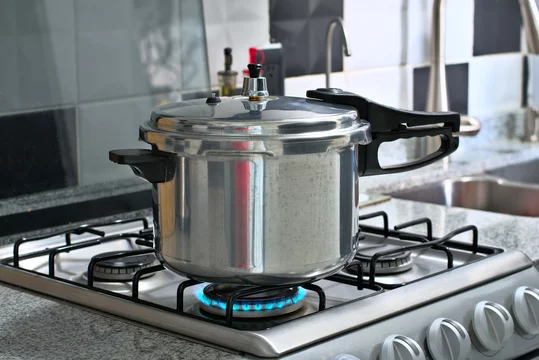8 Foods That Should Not Be Cooked In A Pressure Cooker

Pressure cookers are widely used for their convenience and efficiency in cooking. They help save time and retain the nutrients in food due to their sealed and pressurized cooking environment. However, not all foods are suitable for cooking in a pressure cooker. Certain ingredients can be adversely affected by the intense heat and pressure, leading to undesirable outcomes. In this article, we will explore eight foods that should not be cooked in a pressure cooker and explain the reasons behind their unsuitability.
8 Foods That Should Not Be Cooked in a Pressure Cooker
- Delicate Seafood
- Leafy Greens
- Pasta
- Dairy-Based Sauces
- Crispy Fried Foods
- Cakes and Baked Goods
- Thickening Agents
- Fermenting Foods
1. Delicate Seafood
Delicate seafood, such as fish fillets, scallops, and shrimp, are better cooked using gentle and precise methods. The high pressure in a pressure cooker can overcook these items quickly, resulting in a rubbery texture and loss of flavor. Steaming, grilling, or sautéing are more appropriate cooking methods for delicate seafood, allowing for better control over the cooking process.
2. Leafy Greens
Leafy greens, such as spinach, kale, and lettuce, contain a high water content that can cause them to wilt excessively under pressure. Pressure cooking these greens can lead to a mushy and unappetizing result. Instead, these vegetables are best enjoyed when sautéed, steamed, or used raw in salads.
3. Pasta
Cooking pasta in a pressure cooker may seem like a time-saving idea, but it often results in overcooked and mushy noodles. Pressure cooking does not allow for the proper absorption of water, and the high heat can break down the starches quickly. To achieve perfectly cooked pasta, it is recommended to follow traditional stovetop cooking methods.
4. Dairy-Based Sauces
Sauces that are dairy-based, such as Alfredo sauce or béchamel, are prone to curdling when cooked under high pressure. The intense heat can cause the milk proteins to separate, resulting in a lumpy and unappetizing texture. It is advisable to prepare these sauces using traditional stovetop methods, where the heat can be controlled more effectively.
5. Crispy Fried Foods
READ ALSO » 7 Simple Tips To Remove Burnt Smell From Cooked Rice
Foods that rely on a crispy texture, such as fried chicken, battered fish, or French fries, should not be cooked in a pressure cooker. The sealed environment of a pressure cooker traps moisture, preventing the desired crispness from developing. Instead, these foods are best prepared using conventional deep-frying methods to achieve the desired crunch.
6. Cakes and Baked Goods
Although some pressure cookers come with specific settings for baking, certain delicate baked goods, such as light sponge cakes or flaky pastries, are not suitable for pressure cooking. The intense heat and steam can disrupt the delicate structure of these items, resulting in a dense or soggy texture. It is recommended to use an oven for baking cakes and other delicate baked goods.
7. Thickening Agents
Foods that rely on thickening agents, such as cornstarch or flour, should be avoided in pressure cookers. The high heat and pressure can cause these agents to break down quickly, resulting in a thin and watery consistency. It is better to thicken soups, stews, and sauces after pressure cooking using traditional methods.
8. Fermenting Foods
Pressure cooking is not suitable for fermenting foods, such as yogurt or sourdough bread. Fermentation relies on specific temperatures and timeframes to cultivate beneficial bacteria and develop unique flavors. The high heat and pressure of a pressure cooker can disrupt the fermentation process, leading to inconsistent results.
While pressure cookers are versatile and efficient kitchen appliances, there are certain foods that are better suited for alternative cooking methods. Delicate seafood, leafy greens, pasta, dairy-based sauces, crispy fried foods, cakes and baked goods, thickening agents, and fermenting foods should be avoided when using a pressure cooker. Each of these foods has unique characteristics and cooking requirements that may not align with the high-pressure environment of a pressure cooker.
By understanding the limitations of a pressure cooker and choosing appropriate cooking methods for these foods, you can ensure better results and preserve the desired textures, flavors, and nutritional profiles.
Experimenting with different cooking techniques allows you to make the most out of your ingredients and create delicious meals. Whether it's sautéing delicate seafood, steaming leafy greens, boiling pasta on the stovetop, or frying crispy foods in hot oil, these traditional methods offer more control over the cooking process and help you achieve the desired outcomes.
READ ALSO » Top 10 Effective Tips On How To Work Under Pressure
In summary, while pressure cookers are valuable tools in the kitchen, it's important to recognize their limitations. Certain foods require specific cooking methods to retain their textures, flavors, and overall quality. By avoiding pressure cooking for delicate seafood, leafy greens, pasta, dairy-based sauces, crispy fried foods, cakes and baked goods, thickening agents, and fermenting foods, you can ensure better culinary results and elevate your cooking skills.
Remember to always refer to reliable recipes and cooking guidelines when exploring new techniques to ensure the best outcomes. Happy cooking!
